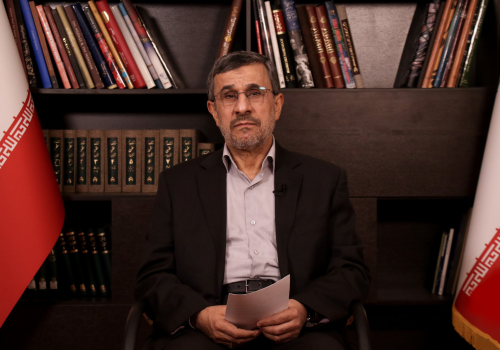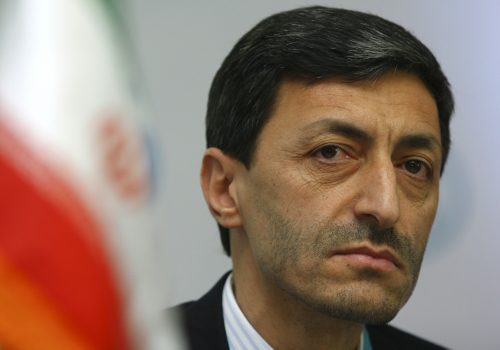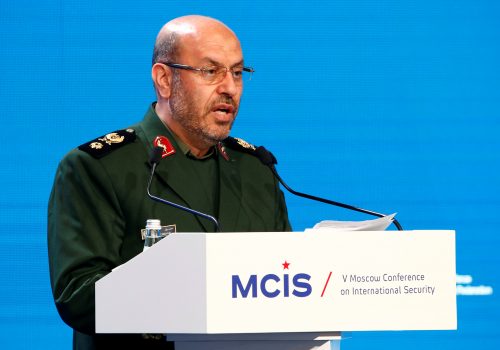Will Iran let a woman run for president in 2021?
With Iran’s June 2021 presidential elections approaching, a perennial public debate over whether women have the right to run for president has resurfaced.
In a statement on September 13, Abbas-Ali Kadkhodaei, spokesman of Iran’s Guardian Council—which is responsible for vetting candidates for elected office—said that there was no legal impediment to a woman president and that it is possible that this will happen in the future. Kadkhoadei was reiterating a position he expressed before the 2017 presidential elections. At that time, he also noted that the Guardian Council had not yet given a binding constitutional interpretation on the matter.
At issue is Article 115 of the Iranian Constitution, which states that one of the criteria for a presidential candidate is being rajol-e siasi, an Arabic term which can be interpreted as a “political man” or a “political personality.”
Iranian women have sought permission to run for president since the late 1990s. In 1997, Azam Taleghani, then a 53-year-old women’s rights advocate, made history by becoming the first woman to register as a candidate for president. “It is the fate of half of Iran’s population that is at stake,” she said at the time. The Guardian Council, arguing that Article 115 refers only to men, rejected Taleghani’s candidacy, as well as the candidacies of all the women who have tried to run since then.
Faezeh Hashemi, a women’s rights advocate and daughter of former president Akbar Hashemi Rafsanjani, has flirted with presidential runs in the past and opined on the issue, saying on September 28 that, while Kadkhodaei’s remarks were good news, the Guardian Council should officially rule that women meet the criteria of rajol-e siasi. Hashemi noted that her late father argued that the use of the term “rajol” by Iran’s Assembly of Experts, which drafted the constitution after the 1979 revolution, was intended to allow women to run for president. However, the social atmosphere became more conservative after the revolution and women’s rights were severely curtailed. Hashemi asserted that there is now support in both conservative and reformist political camps in favor of letting a woman run.
Parvaneh Salahshouri, a sociologist and former reformist member of parliament (2016 – 2020) who criticized the undemocratic aspects of the Islamic Republic during her four-year term, adopted a more skeptical approach to Kadkhodaei’s remarks by noting that there is a big difference between words and deeds. Salahshouri mentioned several women who have the required political and administrative experience, including: Masoumeh Ebtekar, President Hassan Rouhani’s deputy for women’s affairs and the highest-ranking woman in the government; Shahindokht Molavardi, former vice president for women and family affairs in Rouhani’s first cabinet; and Marziyeh Vahid-Dasdjerdi, a medical doctor and former conservative member of parliament, who served as President Mahmoud Ahmadinejad’s health minister.
Prior to the 2017 presidential election, Hossein Anvari, a member of the central council of the conservative Islamic Coalition Party, expressed the view that a woman is not allowed to hold power in an Islamic society. He asserted that the Iranian constitution recognizes the president as the head of the executive branch and as the supreme political authority, second only to the Supreme Leader, and that women, therefore, should not be allowed to serve in that role.
However, this time, some conservative activists have been more supportive of the idea of women candidates, albeit with reservations. Elham Aminzadeh, a former conservative lawmaker and former vice president for legal affairs in the Rouhani administration, said in early October that there is now greater social acceptance for a woman as president in an interview. She noted that when she served as vice president, she never encountered any problems during visits to the provinces and even in consultations with clerics.
Morteza Talaei, a former conservative member of the Tehran City Council and the former chief of Tehran’s police, said that if the issue of women’s participation in the presidential election is legally resolved by the Guardian Council, then the conservatives could run a female candidate. What matters is not whether the candidate is male or female or has a military background, he said, but the candidate’s ability to manage state affairs.
The willingness of the Guardian Council to reconsider the issue indicates growing recognition on the part of the religious establishment that it needs to address public demands to confront widespread discrimination against women.
After the revolution, women lost many rights, were forced to wear the hijab, and the age of marriage was reduced from eighteen to nine. Women retained the right to vote and run for parliament but were almost completely excluded from the decision-making process at the national level. It was only in the mid-1990s that a woman was appointed deputy minister. Then, in 1997, reformist President Mohammad Khatami named Ebtekar as one of his vice presidents. Ebtekar, who served as the spokesperson for the Iranian students who took over the American embassy in 1979, has since become one of the dominant personalities in Iran’s reformist camp.
In 2009, Ahmadinejad named three women to his cabinet, but only one, Dastjerdi, got parliamentary approval. Rouhani, on the other hand, failed to fulfill his election promise to appoint women as cabinet ministers and has settled for naming several as vice presidents.
In recent decades, human rights activists have had some success passing laws that reduce discrimination against women in regard to marriage (the legal age for women is now thirteen), divorce, child custody, inheritance, and insurance compensation. In the run-up to the February 2016 parliamentary elections, dozens of social activists launched a public campaign aimed at significantly increasing representation of women. This campaign yielded some success, as the number of female MPs rose to a then unprecedented—though still small—number of seventeen.
Achieving significant change is difficult due to continued opposition from the hardline clerical establishment, which considers women dangerous and liable to undermining revolutionary values. Despite the Guardian Council’s spokesman’s comments, chances remain slim that the Council will allow a female candidate to run in Iranian presidential elections in the near future.
Past experience has shown that conservative female politicians do not necessarily promote women’s rights and have sometimes even voted against legislative proposals that seek to advance the status of women. In her interview ahead of the 2016 parliamentary election, women’s rights advocate Salahshouri criticized female lawmakers who have supported legislation restricting women’s rights, suggesting that “these women are not women.”
Nevertheless, social and demographic changes in Iran—including the fact that more and more women are college educated—are encouraging women’s integration into public life and intensifying pressure on clerics and politicians to adjust. Thus, even if the Guardian Council continues to punt on the issue of a woman presidential candidate, it cannot stop the movement for women’s rights.
Dr. Raz Zimmt is a research fellow at the Institute for National Security Studies (INSS) specializing in Iran. He is also a veteran Iran-watcher in the Israeli Defense Forces. Follow him on Twitter: @RZimmt.
Image: Faezeh Rafsanjani (C), daughter of former Iranian president Akbar Hashemi Rafsanjani, attends a protest at the Ghoba mosque in northern Tehran June 28, 2009. QUALITY FROM SOURCE REUTERS/via Your View


